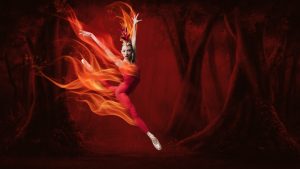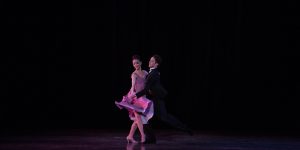
Nathalia Arja in The Firebird. (Photo by Karolina Kuras)
The central focus of Miami City Ballet’s Program Three, performed Feb. 21-23 at the Kravis Center for the Performing Arts, was concentrated on the brand-new staging for the newly acquired ballet Firebird. The production itself was visually resplendent with its translucent and mystical 3D special effects and its vibrant and rich costumes, sets and lights. It was a sumptuously gift-wrapped Firebird.
The history of Firebird has spanned 110 years. It began with the Ballet Russes when Russian impresario Serge Diaghilev asked a young Igor Stravinsky to create his first ballet score for Michael Fokine’s evening-length ballet of a famous Russian fairytale. The three-act ballet that told the story of a magical bird, a prince, a princess and — of course — an evil sorcerer, was an immediate success from the moment it premiered in Paris in 1910.
Balanchine choreographed his first of four versions of the fairytale in 1949, which was an abbreviated version of the full-length ballet and set to an orchestral suite pulled from the original Stravinsky score. If it were not for the copious synopsis in the program, the storyline of the original fable would have been very hard to follow in this reincarnation of the ballet.
In 1970, Balanchine reworked his Firebird together with Jerome Robbins, who recreated the centerpiece of Scene 2 choreographing a flurry of dancing monsters who served as a seething background to the evil Kastchei’s wrathful moves. He also engaged the artist Marc Chagall to design the costumes and set, which were an integral part of the success of the work. These sets and costumes are the reason why this version of Firebird is only performed by New York City Ballet in New York City. They are just too valuable and delicate to travel.
From the program notes and press releases, it is clear that securing Firebird for MCB’s repertory has been a dream of Artistic Director Lourdes Lopez for some time. She herself danced many roles in it while training and dancing with New York City Ballet from a 14-year-old extra in the wedding scene, to a monster in the woods, to the lead princess and finally to the principal role of the Firebird.
When Wendall K. Harrington, creative director and projection designer, who just finished the fabulous new MCB production of The Nutcracker, came to Lopez to propose a new production of Firebird for MCB, Lopez ran — if not jetéd — to the Jerome ^Robbins Rights Trust and secured permission to mount a new production of the Balanchine/Robbins work. She was granted this first time honor as long as Lopez oversaw the design herself and that the new production maintained the feel of Russian folklore. Lopez added to the creative team Anya Klepikov for the set and costume design, and James F. Ingalls for the lighting design.
Klepikov, who was born in Crimea, used the saturated colors painted on the black lacquer Russian palekhs boxes together with her childhood love for Russian fairytales as her inspiration to design her costumes and set. To set the mood at the very beginning of the ballet and as conductor Gary Sheldon led the Opus One Orchestra through the Stravinsky score, an enormous, brightly colored painting of the exotic firebird on a black background dominated center stage.
The most effusive scene was the Robbins choreography in Scene 2, when 28 wildly colored, monster characters suddenly appeared and tormented Prince Ivan in a wild frenzy of movement. Like a deep dive into an animated Disney film at IMAX, the utter creative zaniness of the stylized and iridescent characters was both startling and delightful. I was taken back but also amazed at the many different monsters’ costumes and masks.
From the head-to-toe wine-red, pot-bellied satyrs whose animal legs shook with silicone follicles to the Avatar-blue, unitarded maidens each with two long golden braids and strange, glowing-green leafed beings with dead branch heads — it felt too much for me to take in. Was it too out there for this type of classical ballet story or was this the way to take a ballet like this into the future?
In contrast, the stately pageantry at the end of Firebird felt like one had gently opened Pandora’s box. One gorgeous image after another slowly came to life much like what might happen if one were looking at a book of illustrations of Russian fairytales. Harrington’s projections were marvelous, especially when the tree trunks transitioned into the faces of the 12 knights thus freeing them from an evil magic spell.
All of images glowed in Scene 3 as they were bathed in a saturated gold light that emphasized the beauty of the rich coloring and costumes such as when the 12 knights in silver helmets stood head to head with the 12 princesses in their large pearled kokoshniks (the traditional, elaborate Russian head pieces). In tasteful simplicity, they dropped their heads from side to side slightly while translucent scrims rose and descended showing projections of a golden sun.
Eventually the stunning setting of the wedding of the prince and princess was revealed on various levels with red banners flying. My eyes enjoyed the rest from the cauldron of movement that had been onstage in the scene before and I found myself happily savoring the final fairytale magic of the production while enjoying the Opus One Orchestra’s excellent playing.
On Feb. 22, the role of the Firebird was tersely danced by Nathalia Arja. Proud and bold like a peacock, Arja did not wear the traditional red tutu but instead wore an intense, red lamé unitard complete with red pointe shoes which made her look more like a Cirque de Soleil performer than a ballerina. Prince Ivan was played by the boyish Chase Swatosh and his Princess/Bride was the flowing and elegant Jordan-Elizabeth Long. The sorcerer Kastchei was effectively played by veteran dancer Reyneris Reyes.

The other company premiere in Program Three was wisely selected to open the show as it was much more subdued. In hindsight, Rodeo: Four Dance Episodes, choreographed by Justin Peck, resident choreographer and newly appointed artistic advisor of New York City Ballet, was a sharp contrast to Firebird not only visually but also musically and choreographically.
When it was premiered in 2015 by NYCB, it was touted as a great success as it broke many ballet conventions. Peck had daringly choreographed the work to a symphonic suite that Aaron Copland arranged from his well-known score for Agnes de Mille’s well-loved ballet Rodeo.
De Mille’s 1942 American West ballet is so iconic that is almost impossible (if you’ve seen it as many times as I have) not to visualize her distinctive Americana moments and charming story of a tomboy girl who falls for the lead cowboy. Peck’s interpretation of this popular Copland score is not at all about the Old West but it is still 100 percent American, as it paired youthful energy and wide-open spaces with a sense of playfulness and a dash of sensitivity.
The sleek and contemporary looking Rodeo: Four Dance Episodes was set on an open and bright stage with the floor, backdrop and side drapes all the same shade of pale gray. Dressed in different colored costumes that looked like stylized sports uniforms, 15 men began the dance by lining up on one side of the stage looking like sprinters at a track event. As they crisscrossed the stage in high-octane spirit, the men formed “teams” as interacted — sometimes competing and sometimes aiding each other.
In the cast, there was only one female dancer, Jennifer Lauren, who tried to join the pack of male dancers, and this might have been Peck’s way to pay homage to de Mille’s Rodeo. Renan Cerdeiro was an electric force onstage as he zipped in and out of his fellow dancers and partnered Lauren. Shimon Ito, Alexander Peters and Kleber Rebello, dressed in matching rust costumes, were a dynamic trio especially when their mates tossed them high up in the air. At one point, Rebello did a nice little technical trick — an impressive series of turns a la seconde that got slower and slower and slower.
The middle of the program was rounded out with Nine Sinatra Songs, an audience favorite, which was choreographed in 1982 by Twyla Tharp and featured seven couples, dressed in evening finery designed by fashion designer Oscar de la Renta. The chain of duets, each with a different style of ballroom dancing, were set to some of Frank Sinatra’s most well-known hits such as “Strangers in the Night,” “Somethin’ Stupid,” “That’s Life,” among others. There were also two reprises of “My Way,” where all the couples came onstage to dance together with each doing their own sequence of steps.